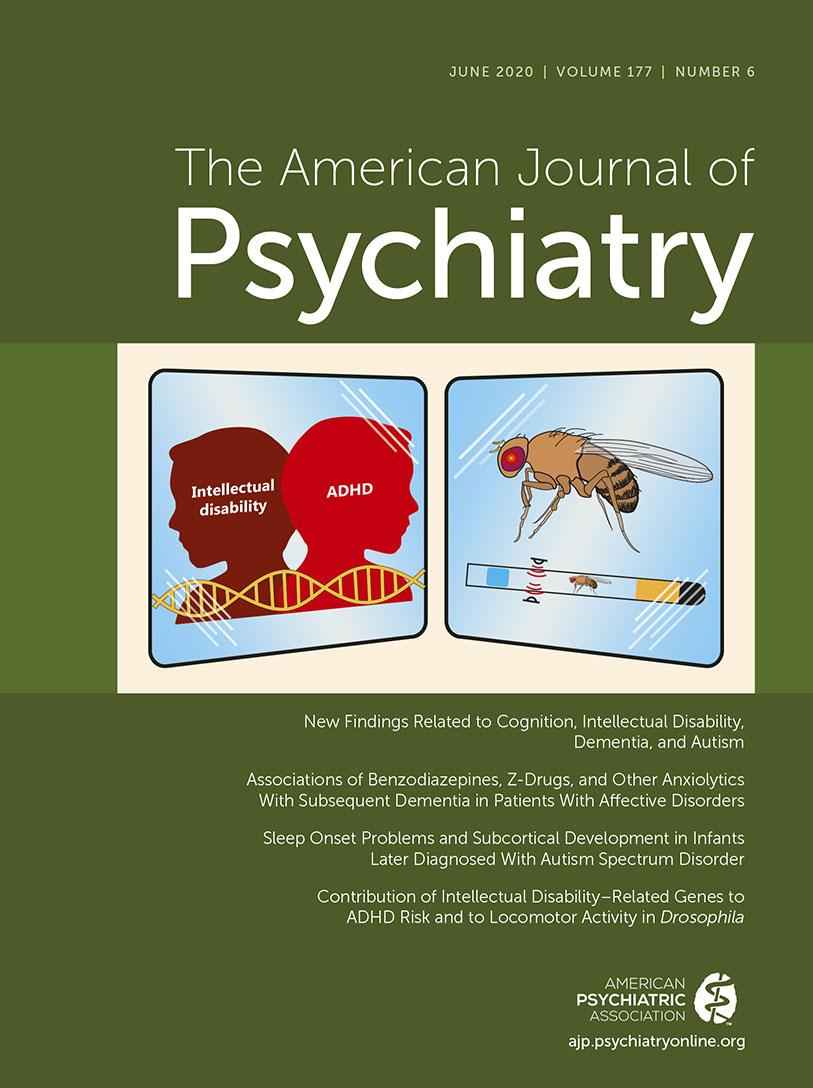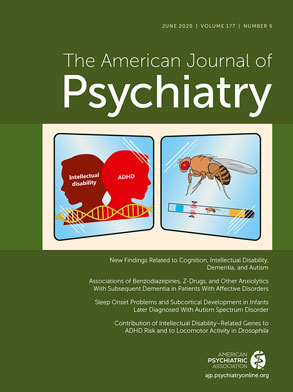The prevalence of antenatal depression and anxiety disorder among pregnant women is estimated at 20% (
1) and 15% (
2), respectively. Given serious known consequences of these common psychiatric conditions for mothers and their newborns (particularly depression, which exceeds hemorrhage and hypertensive disorders as a cause of maternal mortality [
3]), and the fact that rates of maternal antidepressant use in pregnancy have steadily risen in the United States (
4), the stakes of “getting it right” about associations between such use and major adverse neurodevelopmental outcomes among offspring have never been higher. In this issue of the
Journal, Vega et al. (
5) report a meta-analysis in response to a 2014 position statement by the Agency for Healthcare Research and Quality indicating that studies of prenatal antidepressant safety have been inadequate “because comparison groups were not exclusively depressed women.” Since that time, a continued proliferation of association studies and three meta-analyses of published data in relation to autism have not heretofore systematically examined the contribution of comparison group selection, and the results of doing so in this unique study presented in the
Journal have yielded critical new information on the safety of maternal antidepressant use.
Specifically, in their meta-analysis, Vega et al. compared summary odds ratio and hazard ratio estimates (i.e., for offspring autism as a function of maternal antidepressant exposure) between groupings of exposed and unexposed mothers reported from the original studies, in which control mothers were selected from the general population of pregnant women (available for 13 of 14 published studies meeting quality criteria for meta-analysis), pregnant women with a lifetime history of depression (available for six of the 14 studies), and mothers of full siblings discordant for autism (available in four of the 14 studies). The comparison revealed that the strength of association between maternal antidepressant exposure and the occurrence of autism in offspring differed significantly as a function of control group selection. For the studies in which general population control data were incorporated, the association was positive, with a statistically significant odds ratio on the order of 1.6. When restricting control groups to mothers with a lifetime history of depression, however, the meta-analytic result for association between maternal antidepressant exposure and offspring autism was not statistically significant, and when considering families with discordant sibling pairs, the data actually suggested a statistically significant protective effect (with the exposed sibling less likely to develop autism). Separate runs of meta-analysis for each control condition were conducted for the effect of a) any antidepressant, b) selective serotonin reuptake inhibitors (SSRIs) only, c) any trimester exposure, and d) first trimester only. Importantly, there was almost complete uniformity of the results for strength of association across these disparate tests (a–d) within each control group type. The 14 qualifying studies were comprised of eight cohort studies and six case-control studies encompassing 3,650,230 children from the United States, Canada, Denmark, Finland, and Sweden. The authors demonstrated that the differences in results as a function of control group selection were highly statistically significant, that the resulting profile did not support an association between prenatal antidepressant exposure and autism, and that additional heterogeneity across the studies could be accounted for by a lack of careful control for effects of population stratification on the basis of ethnicity. They concluded that comparator group selection strongly influences the observed antidepressant-autism spectrum disorder (ASD) relationship, for which general population associations were likely mediated by unmeasured maternal psychiatric burden or transdiagnostic genetic liability.
These findings highlight key considerations in contextualizing associations between environmental exposures and inherited conditions, which is a central theme of the entire discipline of psychiatry, given the substantial role of polygenic inheritance for nearly all neuropsychiatric disorders. In the case of autism, which has one of the highest heritability rates of all (on the order of 85%), it is a first principle that a relevant exposure should track with differential affectation within a family. It is a particular strength of this meta-analysis to have incorporated discordant sibling data, given that it is unfortunately rare for exposure studies to be conducted within genetically informative study designs. As the authors astutely point out, it is easy to become infatuated with studies of extremely large sample sizes derived from large-scale national registries and health care databases, but they are not designed for unbiased analyses of causation and commonly fail to achieve the level of rigor afforded by studies (usually much smaller) that adequately control for both genetic and family-level environmental influences.
The principle of reliance on genetically informative data as a prerequisite for confirmation of the effects of environmental exposures on heritable conditions is well worth emulating and applies to explorations of many other putative environmental risk factors for autism (e.g., air pollution, pesticide, and heavy metal exposures), as well as for exposure risks for other psychiatric conditions (e.g., the effects of low income on mood or psychotic disorders). A nuance of the Vega et al. study is that the exposure itself is related to another partially inherited psychiatric condition for which there exists steadily mounting evidence of transdiagnostic overlap in genetic susceptibility (
4). Such pleiotropic susceptibility is a remarkable new reality in our understanding of all psychiatric disorders and underscores the need to control rigorously for nonintuitive associations between exposure and outcome relating to genetic factors that are shared between family members (in this case the mother and her offspring) but may contribute to disparate disorders (depression and autism) in different members of a family. To provide an example of how an exposure can be linked to inherited liability for autism but not responsible for its transmission to the next generation, it was observed in the Nurses Health Study II that subclinical autistic traits of parents predicted elevation in risk of autism to offspring (
6) and were also associated with higher rates of victimization of mothers during their own childhood (
7). In the absence of control for genetic transmission of inherited liability indexed by these traits, it may have otherwise been inferred that childhood victimization of mothers raises the risk for autism in their offspring. In the Vega et al. study, the use of an antidepressant during pregnancy is the exposure in question, but understanding that this exposure may constitute an effect of a more proximal cause of autism (e.g., overlapping inherited liability for depression and autism) clarifies that contrast groups must be appropriately representative of the underlying liability to avoid a spurious inference.
An important caveat to the conclusions in this article—one which the authors acknowledge—is that none of the studies specifically ascertained current or active depression during pregnancy; rather, they relied on a lifetime history of depression in the selection of “psychiatric controls.” This serves the purpose of ascertaining for inherited predisposition to depression but cannot address possible adverse interactions between maternal depressive states during pregnancy and (simultaneous) antidepressant exposure. Related to this limitation is a general lack of precision in specifying the timing of antidepressant administration in exposed pregnancies and the possibility that women with lifetime histories of depression may have been exposed to antidepressant medication in the months prior to pregnancy. Inclusion of the latter in the “unexposed” group could conceivably operate to falsely attenuate estimation of enduring effects of antidepressant exposure on offspring if the mechanisms of the antidepressant-ASD association were to involve modification of maternal serotonergic function during embryonic development. This has been suggested in previous reports of associations between antidepressant use during the preconception period and increased ASD risk (
8,
9). Specifically, in early brain formation, before the endogenous serotonergic fibers reach the forebrain, placental serotonin is the transient source of serotonin for the developing forebrain (
10). Prolonged antidepressant therapy has been shown to alter serotonin receptor populations in number and by desensitizing the receptors or decoupling them from signaling molecules, a change that may persist following drug cessation (
11). Thus, changes in maternal serotonergic function could conceivably mediate deleterious effects on fetal brain development. Although first-trimester exposures were separately explored in this meta-analysis, confounds incurred in the analysis of psychiatric controls (presumed unexposed but with earlier exposures) could operate in the direction of weakening of association in this control condition in comparison to the general population.
Current versus historical maternal depression and antidepressant therapy are issues that cannot be resolved without higher-resolution data on clinical course and timing of exposure. As pointed out by Vega et al., randomized clinical trials cannot be conducted to evaluate consequences of antidepressant exposure during gestation because of ethical considerations. Another important tool for exploring these possibilities lies in experimental systems that allow direct tests of causality and biological mechanisms. Studies of this kind are of limited clinical relevance at this time because of broad failure of animals to recapitulate the autism phenotype when affected by genetic changes that are associated with autism in humans. Nevertheless, rodent studies have initially addressed the influence of antidepressant drug exposure alone on the developing brain (i.e., in the complete absence of maternal psychiatric stress) and have shown persistent alterations in the serotonin system of offspring following developmental antidepressant exposure through the mother (
12–
17). Recently, in an extensive study of the mouse system designed to examine the impact of maternal SSRI exposure across varying durations of pregnancy and lactation at exposure levels equivalent to the maximum recommended human dose (
18), a robust influence of maternal SSRI exposure on offspring early communicative behaviors and mature sensory reactivity and social behaviors was observed. The severity of these behavioral disruptions was mediated by the duration of exposure, suggesting that there may be critical windows of exposure that result in enduring alterations in social behavior of offspring, which remains to be explored for all placental animals, including humans, and within specific subpopulations who may be uniquely vulnerable to such effects.
For the here and now, studies indicate that more than 40% of women discontinue their medication during pregnancy (
19,
20), elevating their relapse risk of depression (
21), with more than two-thirds of women relapsing (
22). Thus, it is vital that pregnant women who are in need of antidepressants have discussions with their physicians not only about the risks of treatment (one of which is the focus of the study by Vega et al.) but also about the risks of not treating. The data presented by Vega et al. indicating no evidence of an association between prenatal antidepressant use and ASD when considering studies with appropriate comparison groups and/or genetically informative designs continue to support the current guidelines of the Food and Drug Administration, the American Psychiatric Association, and the American College of Obstetrics and Gynecology. Specifically, these guidelines promote the necessary use of these lifesaving medications in clinical scenarios in which symptomatology is pronounced, psychosocial therapies have failed or are insufficient, and the risk for both the mother and the infant of not treating overrides the risk of medication exposure. In light of this analysis and the data available to date, clinicians should continue to feel comfortable utilizing these medications when they are clinically indicated.

